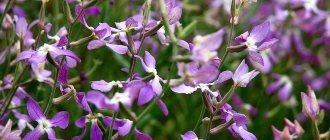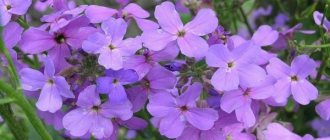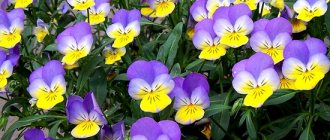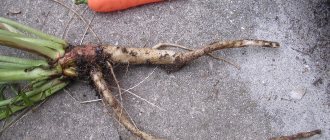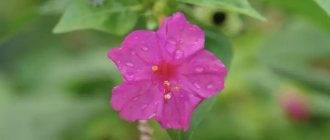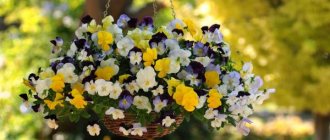Among the perennial ornamental plants, the nocturnal plant or night violet stands out with its unusual aroma. It has been grown in European gardens and parks since the 16th century. The night violet flower is called hesperis, from the Greek word “hesperis” - evening. The bright inflorescences open and begin to smell fragrant after sunset. Thanks to the plant's unpretentiousness and excellent decorative qualities, it is cultivated by gardeners all over the world. In Russia, nocturnal plants with lilac, purple and pinkish petals are most often found. But true lovers of hesperis will definitely grow varieties with snow-white and red double inflorescences.
The shape of hesperis inflorescences resembles phloxes
Botanical description and distribution
Matron's noctule or hesperis is a perennial herbaceous plant from the cruciferous (cabbage) family. It can be found in the Mediterranean, the Caucasus, Europe, Asia and Western Siberia. Gardeners brought the flower to North America, where it took root well. There are about 30 species of noctule. The shape of the inflorescences of Hesperis is similar to phlox; one of its many names is “bull phlox”. Under natural conditions it grows in meadows, forest edges, along ponds and roads.
The erect stem of the noctule reaches a height of 80-100 cm. It branches in the upper part. The leaves are green in color with jagged edges and lanceolate in shape. The size of the leaf plates is 3-4 cm wide and 12 cm long. They are covered with silky hairs. Small flowers are collected in loose racemes. The abundance of colors will delight gardeners - lilac, pink, violet, white and lilac shades will create a riot of colors in the flower beds. Each flower has 4 petals with a diameter of 2 cm or more.
Information. Night violet is a common name among decorative flowers. Hesperis is often confused with Matthiola bicorne, which is also called night violet.
The flowering of the brush begins in May and continues until the end of July. The petals gradually open from the periphery to the center of the inflorescence. The spectacular brush can grow up to 20-30 cm in length. The fruits of Hesperis are narrow, flattened pods with brown seeds arranged in two rows. Seed size is 3 by 1 mm. They have good germination, lasting up to two years. In hot weather, the flowering period is shortened. For the unique aroma that appears in the evening, the plant is called night violet.
Advice. Timely cutting of dried inflorescences will help prolong the flowering of noctule.
Decorative culture refers to biennials. In the first year of development, a dense rosette of oval lanceolate leaves is formed. In some cases, small flower stalks are formed. By the end of May of the second year, a stem with lush inflorescences will appear. From the third year, the ability to flower drops sharply, old plants give way to young ones.
Night violet in landscape design
By combining “day flowers” with night violet, you can create extraordinary fragrant floral arrangements . The most unique aromas can be obtained by planting violets and climbing varieties of roses or herbs (basil, sage, thyme, lemon balm) in the same flower bed. The most beautiful combinations: night violet and viola, petunia, nasturtium, geranium. But when combining plants, it should be taken into account that:
- violet grows quickly, so do not place crops tightly;
- violet is an early plant, so it should be planted next to late crops to get a flower garden that will please you for a long time.
To prolong the flowering of violets , it can be planted in several stages at intervals of 10-15 days, then plants planted at different times will bloom in turn. In addition, it is worth noting that flowering can be extended almost 2 times simply by placing the crop in partial shade. And to make the flowering more magnificent, faded buds need to be cut off, leaving a few for seeds if necessary.
Many varieties of violets are actually perennial, however, their best flowering occurs in the second year: in the first year, the plant does not have time to gain color, and starting from the third, there are fewer and fewer flowers. Therefore, gardeners use this crop as a biennial crop, renewing the plantings gradually so that every year some of the plants in the flowerbed are biennial.
Night violet flowers are distinguished not only by their unpretentiousness and the opening of buds at night. The main feature of these plants is their wonderful aroma, which can turn a garden or balcony into a romantic and inspiring place when the sun sets.
Types of noctule
Most cultivated varieties have simple flowers, but double flowers are also found. In gardens and parks you can find several unpretentious, but fragrant and attractive plant species.
Matron's Evening Violet
An ornamental plant that prefers loose soil. Blooms in the second year of life. Purple flowers are collected in large cylindrical racemes. They have a strong, persistent aroma. Flower diameter is up to 2 cm. Can be grown by direct sowing in the soil in May-June.
Hesperis Romance
A popular decorative biennial with single or double white flowers. The plant is characterized by a persistent pleasant aroma exuded at night. It prefers light areas, but also feels good in partial shade. Used for cutting and designing group flower beds and paths.
Hesperis Inspiration
Branched biennial with simple flowers of lilac, purple or white color, collected in brushes. Prefers slightly alkaline soils. The plant is suitable for planting in mixborders or gardens. Height 80-90 cm. Abundant fragrant inflorescences will decorate any bouquet. It is frost resistant.
Matron's Evening Crimson
An unpretentious flower known as night violet. The branched, erect stems are decorated with many crimson flowers. At night and in the evening, the biennial spreads a pleasant fragrance. Blooms from May to July. Looks great as a background plant for landscape style gardens. Seedlings are planted in June at a distance of 30 cm from each other. Can reproduce by self-sowing.
Evening night beauty
One of the most fragrant varieties of hesperis blooms in the second year after planting. Its flowers of a soft lilac hue are collected in beautiful large brushes. The plant is resistant to frost and disease. It grows to a height of 50-75 cm. The flower is suitable for cutting and is used in group and single plantings. Can be grown on the balcony.
Evening party sad, dark
One of the rare plant species, Hesperis tristis L. Found in central and southern Europe. Its height is 25-50 cm. The light-loving and moisture-loving plant grows on clay and sandy soils. The brushes are large, the flowers are whitish or cream, covered with red veins. The petals are oblong in shape with a blunt tip, their length is 2-3 cm. It blooms from May to June. The leaves of the basal rosette grow up to 10 cm, the stem leaves are shorter.
Propagation using seeds
To properly plant flower seeds in open ground, you must adhere to the following rules:
- Sowing should be carried out from May to October. If you do this in the fall, small shoots will appear in early spring, as soon as the snow melts.
- Seed grains should be buried in moist soil at a depth of 1–2 cm.
- The plant tolerates replanting well; to do this, you need to dig up the flower and, together with a lump of earth on the roots, plant it in the planned place.
- The space between violet bushes should be 30–40 cm.
- Plants begin to bloom in the second year, but if planting is done early, the first flowers will appear at the end of August.
- Night violet can reproduce by self-sowing.
- Seeds usually ripen in late summer - early autumn.
Selection of location and soil
It is recommended to plant night violets in lighted areas. In the lowlands, where meltwater stagnates and snowdrifts lie for a long time, it is better to plant plants. Excessive moisture will lead to rot on the leaves. Hesperis feels good in partial shade; it can be placed under the crown of a tree.
Priming
The plant grows well in slightly alkaline soils. It loves air, so loosening is advisable after each watering. Neutral fertile soil is also an acceptable option. But acidified peaty areas are unacceptable; the noctule will die on them. One of the significant agrotechnical measures is regular weeding. Weeds should not be allowed to grow.
Watering
Overmoistening is not desirable for night violets, so you should take care of drainage. During the growth period, it is necessary to provide sufficient watering, but without stagnation of moisture. Dryness leads to poor flowering. Watering is done once a week, preferably in the morning.
Top dressing
On depleted soil, before flowering, hesperis needs to be fertilized with complex mineral fertilizers. Then it is enough to add wood ash once a month. It will improve the structure of the soil and make it looser. Wood ash reduces soil acidity and increases plant resistance to infections.
Madonna's veil is resistant to frost, it can withstand temperatures down to -20°C. In winters with little snow, it is better not to risk the ornamental plant and cover it with non-woven material.
How to grow seedlings
The most suitable time for sowing seedlings is the end of March - beginning of April. The seeds need to be planted in a box with soil, and the seedlings should then be transplanted, but you can use small cups for this at once, so as not to have to pick them later.
Seedlings should be grown in this order:
- First you need to prepare the soil with a rich content of organic fertilizers or buy a ready-made one that is suitable for night violets.
- The seeds are poured into the soil to a depth of about 1 cm.
- The distance between future shoots should be at least 2–3 cm.
- After the seedlings appear and the first leaves form on them, they must be transplanted into separate pots.
- For full growth, seedlings need to be provided with good lighting and regular watering.
- When the seedlings reach a length of 8–10 cm, they can be taken out into the open air or onto a balcony if the weather is not too cold.
- After 14–17 days, the seedlings can be transplanted into open ground.
To do this, young violets with a lump of earth on the roots are placed in pre-prepared holes and sprinkled with soil. The distance between them should be 25–35 cm. Then the seedlings must be well watered and continued to be cared for as adult plants.
Growing Hesperis
Planting and caring for the night violet flower is not difficult; the photo shows how profusely it blooms when self-seeding in the field.
Madonna's noctule propagates in several ways: by seeds, seedlings and cuttings.
Advice. To prevent self-seeding plants from filling the entire flowerbed, plant young shoots every three years.
Seeds and seedlings
Noctule pods are harvested after the first frost. Small oblong brown seeds ripen in them. Seeds are sown in the spring after the soil warms up or in the fall. When sowing in spring, the beds are covered with plastic film, creating greenhouse conditions.
The plant also propagates by seedlings. To do this, you will need a container with loose soil fertilized with humus. Seeds are sown in early April, covered with a 5 mm layer of soil. The soil is watered from above and then covered with film. The containers are kept in a room with a temperature of 20°C. After 15-20 days, shoots appear. After the formation of three main leaves, the noctule plant is transplanted to a permanent place. They are seated 25-30 cm apart. During the adaptation period, the plant especially needs watering. The development of the root system is facilitated by air exchange, which ensures loosening. Weeds that slow down the growth of flowers should be promptly weeded.
Cuttings
Terry forms of hesperis do not reproduce by seeds. It is necessary to divide the bush in August-September. For cuttings, side shoots formed on the plant after flowering are used.
We select neighbors for the night violet
Finding partners for the night violet is not difficult. Mattiola goes well with summer flowers such as petunia, nasturtium, viola, as well as with a variety of herbs - lemon balm, mint, basil, thyme, sage, etc. - together these plants create amazing bouquets of aromas and color shades. An interesting combination with noctule is also garden geranium, yarrow, monarda, and cornflower.
A unique combination of aromas occurs if you plant a night violet next to a rose, especially a climbing one.
Top ten most popular varieties
Mirabilis flower or night beauty
The most common, both among experienced flower growers and novice collectors, are:
- The bride's bouquet;
- White Sun of the Desert;
- White mustang;
- White Nights;
- White magic;
- Lady in White;
- Juliet;
- Cotton candy;
- White angel;
- Your Mightiness.
The bride's bouquet
Saintpaulia Bride's Bouquet from the famous breeder Konstantin Morev blooms with large snow-white flowers with wavy petals, and the cream-colored core gives the plant a pearly shine, creating an atmosphere of solemnity.
The White Sun of the Desert variety blooms with snow-white, smooth, medium-sized flowers that most closely resemble wildflowers.
White mustang
The variety called White Mustang looks no less exotic. A velvet fan-shaped flower with a yellow core and blue splashes in the design of dark green leaves looks unusually delicate.
White Nights
Large light blue semi-double stars with a fantasy color. It is this spectacular flower that is called White Nights, and therefore the plant is classified as a subgroup of white violets. The rosette of Saintpaulia consists of several tiers of dark green, velvety leaves, pointed at the edge.
We invite you to familiarize yourself with Stevia: properties and contraindications, planting and care
Lady in White
Another unusual type of white palette is Lady in White. Huge, up to 8 centimeters in diameter, double snow-white stars, with petals wavy at the edges. The rosette is small, neat, light green.
Juliet
In addition to plain snow-white violets, varieties with colored inclusions are also extremely popular. Such beauties include, in particular, the Juliet variety.
Cotton candy
The peculiarity of the Cotton Candy variety is the abundant flowering of snow-white, voluminous, densely double roses, with corrugated edges of the petals. The rosette consists of wavy, toothed, medium green leaves.
White angel
This sport is somewhat different from other varieties of white. Smooth, light, blue-tinged star-shaped flowers in a rosette design consisting of dark green round leaves.
Your Mightiness
The variety Your Grace is a profusely blooming snow-white rose with fan-shaped double petals and a comb type of flowering. The abundance of dark green leaves makes the flower even more spectacular. This flower will be the highlight of any collection, even for the most experienced and spoiled gardeners.
Brugmansia
Tree-like shrub with large gramophone flowers. In its homeland, Latin America, Brugmansia reaches a height of 5 meters, but here you can most often grow a bush. During the day, gramophones stand half-closed, and in the evening they open. Their diameter reaches 15 cm.
It prefers a hot climate, so Brugmansia is most often planted in containers so that they can be moved indoors for the winter. Or they decorate greenhouses with it. Frost-resistant species include “Brugmansia bloody” with bright red buds.
Propagated by seeds, cuttings and layering. Timely pruning and feeding are important in care.
Night violet in landscape design Photos of varieties
Night violet white alba cultivar Hesperis matronalis Alba Plena photo
Hesperis, night violet, Matrona anemone - all this is the name of one beautiful plant. The bush received such a wonderful multifaceted name due to its wide distribution among the regions. In some regions there is another name - “bull phlox” for its comparison with phlox and its impressive size.
Vechernitsa night violet and allium in landscape design Night violet with what to plant
The combination of evening grass together with lupins is interesting, resulting in a fragrant plantation with special romanticism and unique lightness of compositions.
Hesperis matrona looks beautiful against the background of plantations of red tulips: the contrast of red and purple is very harmonious, quite bright, but does not irritate the eye with excessive variegation.
Planting hesperis together with irises is popular: large irises are perfectly shaded by noctule and a very harmonious composition is created.
What to plant with the night violet Cosmos bipinnatus together with hesperis Hesperis matronalis photo in the garden
The combination of Cosmos bipinnate with Hesperis matrona is unique. The bright scarlet inflorescences of cosmos look like fluttering moths against the backdrop of a solid carpet of night violet flowers. For gardeners, night violet will become an assistant in attracting pollinating insects.
What to plant with night violet Poppies and hesperis matrona photo
Designers will appreciate the long flowering and rather large size of the bush. Florists will be able to decorate their bouquets; when cut, hesperis lasts a long time without losing its appearance. The purpose for planting the Matrona anemone on the site is not so important. The main thing is a beautiful appearance and a unique aroma.
More about night violet varieties
Application
Beautiful, fragrant noctule is widely used by landscape designers and amateur flower growers. In addition, it has unique healing properties, therefore it has found its use in folk and official medicine.
Landscape use
Designers actively use Vechernitsa Matrona for landscaping. Their unpretentiousness and long flowering period make these flowers a desirable acquisition not only for private plots, but also for city squares.
Flower beds with fragrant flowers are located near gazebos, verandas, and garden paths. This allows you to enjoy not only modest beauty, but also a sweet floral fragrance.
Night violet looks especially beautiful in group plantings, forming bright spots on ridges, alpine hills or flower beds. The discreet beauty of the flowers looks good with various types of summer flowers and herbs. The combination with the following plants looks impressive:
- petunia;
- chamomile;
- marigold;
- lavender;
- cornflower;
- fern.
Single plants refresh meadow and Moorish lawns well. The long, slender stems are great for cutting into field bouquets. Cut flowers remain fresh for up to 1.5 weeks.
Use in medicine
Almost all parts of the plant - stems, leaves, flowers, seeds - have healing properties. The plant is richest in essential oils, flavonoids, saponins, vitamins A, C, as well as microelements:
- phosphorus;
- magnesium;
- potassium;
- iron.
Decoctions of the leaves are used as a natural diaphoretic. Raw and dried flowers contain large amounts of vitamin C. Therefore, flower decoctions are a good vitamin remedy. Sprouted seeds improve appetite, restore the body's resources, and fight flatulence.

